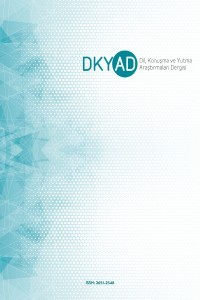
Dil Konuşma ve Yutma Araştırmaları Dergisi
Yazarlar: Sema ACAR
Konular:-
Anahtar Kelimeler:Developmental dyslexia,The endophenotypic approach,Dyslexia-candidate genes,The dorsal-ventralanterior reading brain regions,Phonological awareness,Rapid automatized naming,Working memory
Özet: Developmental dyslexia is a neurodevelopmental disorder characterized by unexpected problems in learning to read, fluent reading, and reading comprehension in spite of age-appropriate IQ level, education, and environmental opportunities (Démonet, Taylor & Chaix, 2004; Vellutino, Fletcher, Snowling & Scanlon, 2004). Fluent reading and reading comprehension require rapid, successive and/or parallel activation and effective communication of multiple brain circuits. Brain “reading” circuits are sustained by multiple and distant neuronal networks which are also involved in language, visual, and orthographic processing, in addition to attention, 1 Öğr. Gör., Başkent Üniversitesi, Odyoloji Bölümü, [email protected] functions, and higher level cognition processing (Norton & Wolf, 2012). However, genetically driven structural and functional differences in these brain circuits might cause problems in these neurocognitive abilities in developmental dyslexia. Therefore, individuals diagnosed with developmental dyslexia or with familial risk might have problems in reading related cognitive, sensorial, and language abilities such as phonological working memory, processing of rapid auditory/visual stimuli, phonological awareness, and rapid automatized naming (see Vellutino et. al., 2004, for a review). In addition, problems in motor coordination and balance are commonly reported (Rochelle & Talcott, 2006). As a consequence of heterogeneity in the clinical profile, various theories have been postulated to explain the underlying mechanisms of the disorder: The Phonological Deficit Theory suggests that problems in phonological awareness, rapid automatized naming, and phonological working memory are indeed the underlying reasons of developmental dyslexia, since these abilities are fundamental to reading development. The theory suggests that the problems in these abilities might be due to the perisylvian cortex dysfunction (Kovelman et. al., 2012). In addition, some researchers propose Double-Deficit Hypothesis. According to which, rapid automatized naming and phonological abilities are closely related with each other but mediated by independent sub-mechanisms. Therefore, individuals having disorders in both might have more severe reading problems (Nelson, 2015). On the one hand, Magnocelluar Theory suggests that the underlying reason of the developmental dyslexia is the synchronization and integration of the rapid visual and auditory stimuli due to medial thalamic and geniculate nucleus abnormalities (Stein & Walsh, 1997). On the other hand, Cerebellar Deficit Theory claims that developmental dyslexia is due to cerebellum disorders (Nicolson, Fawcett & Dean, 2001). Finally, some researchers focus on developmental dyslexia comorbidities such as dysgraphia, dyscalculia, and attention deficit and hyperactivity disorder; therefore, present A Multiple Cognitive Deficits Model (Peterson & Pennington, 2015). By focusing on different underlying mechanism of the disorder, all these theories contribute to the multifactorial nature of developmental dyslexia. However, among them, only the endophenotype approach could encompass the all underlying aspects of the disorder in a holistic manner (Kendler & Neale, 2010). As developmental dyslexia is a neurodevelopmental disorder with genetic, neurologic, and cognitive origins, endophenotype approach to developmental dyslexia proposes to study underlying reasons of developmental dyslexia within the triangle of neurogenetic, neurobiological, and neurocognitive evidence. Accordingly, this approach suggests using neuroimaging endophenotypes (i.e., an assessable neuroanatomical trait considered as the closest link to the biological basis of developmental dyslexia) as an intermediate level to build a link between genotypes (i.e., a genetic organization of an individual) and phenotypes (i.e., qualitative traits such as reading skills). Evidence for developmental dyslexia genotypes comes from molecular geneticneuroimaging studies. Nine developmental dyslexia candidate loci (i.e., from DYX1 to DYX9) and up to ten individual developmental dyslexia associated candidate genes have been reported (see, Becker et al., 2017). A great number of association studies have suggested that genetic risk alleles in three most consistently replicated candidate genes (DYX1C1, KIAA0319, and DCDC2) might be associated with developmental dyslexia related phenotypes and brain regions involved in reading (see Mascheretti et. al., 2017, for a review). In addition, structural and functional neuroimaging studies comprise evidence for the endophenotypes of developmental dyslexia. Various functional and structural neuroimaging studies have reported that dorsal, ventral, and anterior brain regions might be involved in reading related neurocognitive processes; as a result, disruptions in these areas might be correlated with developmental dyslexia related phenotypes (see Ozernov-Palchik & Gaab, 2016, for a review). Finally, the phenotypes of developmental dyslexia are fluent reading and reading comprehension problems which are linked to the problems in cognitive, sensorial, and language abilities such as phonological working memory, processing of rapid auditory/visual stimuli, phonological awareness, and rapid automatized naming. Given all the data within the perspective of endophenotype approach, it could be concluded that the genetic risk alleles in affected individuals might lead disruptions in neuronal migration, which consequently affects brain functions and structures critical for reading skills. The aim of the present review is to explain the neurogenetic, neurobiological, and neurocognitive aspects of developmental dyslexia within endophenotype approach. Firstly, endophenotype approach will be conceptualized within Gottlieb's Epigenetic Psychobiological Systems Perspective. Later, neurogenetic, neurobiological, and neurocognitive origins of developmental dyslexia will be presented respectively. Finally, the importance of endophenotype approach to neurodevelopmental disorders such as developmental dyslexia will be highlighted. In this respect, It is targeted to contribute to the theoretical understanding of early risk factors of developmental dyslexia, as well as developing effective assessment and intervention methods, which reflects the multifactorial profile of the disorder
Dergi editörleri editör girişini kullanarak sisteme giriş yapabilirler. Editör girişi için tıklayınız.